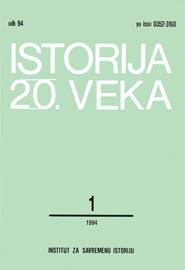POLITIČKO RASLOJAVANJE SELJAŠTVA U SRBIJI 1941. GODINE
POLITICAL STRATIFICATION OF THE PEASANTRY IN SERBIA IN 1941
Author(s): Žarko JovanovićSubject(s): Military history, Political history, Recent History (1900 till today), WW II and following years (1940 - 1949)
Published by: Institut za savremenu istoriju, Beograd
Keywords: Serbia; peasantry; political stratification; 1941; Chetnik movement; partisans; national liberation movement;
Summary/Abstract: In the eve of World War II the peasantry, as the most numerous part of the population (3.102.00 out of 4 million or 79.3%), represented an important factor in relation to economic, military and political power. The peasants were also the most numerous fighting force at the outbreak of World War II and had a deciding influence in the success of the War of National Liberation and the socialist revolution. Many different circumstances existent in the Serbian village influenced the attitude of the peasants in the course of the War of National Liberation. At the time of the uprising in 1941, as well as throughout the war, Serbian peasants found themselves between two opposing movements, partisan and četnik. The conflict between these two movements added the turmoil of civil war to other problems already besetting the peasants which suffered oppression, killing, plundering and maltreatment from the foreign aggressor they were fighting ... In the initial phase of the uprising against fascism, notwithstanding their traditional patriotism and freethinking, the peasants were more inclined to the četnik movement, mainly because joining the Cetniks did not oblige the peasants to leave home and fight as the case was with the partisan movement. As the Movement for National Liberation grew in the autumn of 1941, the situation changed rapidly, so that in most partisan detachments peasants made up between 75% and 90% of the units while their number in the četnik units dwindled despite measures aimed at preventing this, such as forcible mobilization, threats and reprisals.
Journal: Istorija 20. veka
- Issue Year: 1994
- Issue No: 1
- Page Range: 97-109
- Page Count: 13
- Language: Serbian

